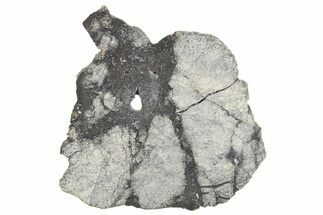This Specimen has been sold.
.59" Lunar Meteorite (.33 g) Slice - Touat 008
This is a .59" wide (.33 gram) slice of the lunar meteorite Touat 008, collected near Adrar, Algeria. Both sides have been cut flat to allow for the lithic clasts to be seen.
Comes in an acrylic display case.
Comes in an acrylic display case.
About Lunar Meteorite Touat 008
Touat 008 is a Lunar meteorite that was discovered in Adrar, Algeria over the month of February, 2023. A total mass of 2.96 kg were collected and sold to Mbark Arjdal over the months of February and May of the same year. It's classified as a troctolitiic melt breccia and is similar in many respects to the Lunar meteorite, Rafsa 002. Touat 008 is a breccia dominated by mineral debris and some lithic clasts related to troctolitic lithologies.
Meteoritical Bulletin: Entry for Lunar Meteorite Touat 008
Touat 008 is a Lunar meteorite that was discovered in Adrar, Algeria over the month of February, 2023. A total mass of 2.96 kg were collected and sold to Mbark Arjdal over the months of February and May of the same year. It's classified as a troctolitiic melt breccia and is similar in many respects to the Lunar meteorite, Rafsa 002. Touat 008 is a breccia dominated by mineral debris and some lithic clasts related to troctolitic lithologies.
Meteoritical Bulletin: Entry for Lunar Meteorite Touat 008
Moon Rocks... On Earth...
Think the only moon rocks on Earth are samples brought back from Apollo missions? Think again!
Lunar meteorites are type of achondrite meteorites that were formed like other stony (chondrite) meteorites, but they were ejected into space by meteorites and other celestial bodies hitting the moon. Almost all lunar meteorites are brecciated amalgamations of feldspathic and basaltic rocks commonly found on the Moon's surface.
Lunar meteorites are pretty rare to find on Earth: the vast majority of meteorites are from the asteroid belt, and less than 1 percent of classified meteorites are lunar in origin. The total mass of all known lunar meteorites is probably less than 1,000 kilograms. Owning a piece of the moon is a pretty rare accomplishment!
One reason they are so rare is because lunar meteorites superficially look just like earth rocks. Even a true meteorite expert would not recognize a lunar meteor laying on the ground among earthly stones. Lunar meteorites have only been recognized in places naturally devoid of rocks, like sandy deserts and ice sheets. In fact, there has never been a lunar meteorite classified from North America, South America or Europe. Most are found in the Sahara Desert (Northwest Africa), Antarctica, or Oman. All Antarctic meteorites are governmental property so they cannot be privately attained.
Think the only moon rocks on Earth are samples brought back from Apollo missions? Think again!
Lunar meteorites are type of achondrite meteorites that were formed like other stony (chondrite) meteorites, but they were ejected into space by meteorites and other celestial bodies hitting the moon. Almost all lunar meteorites are brecciated amalgamations of feldspathic and basaltic rocks commonly found on the Moon's surface.
Lunar meteorites are pretty rare to find on Earth: the vast majority of meteorites are from the asteroid belt, and less than 1 percent of classified meteorites are lunar in origin. The total mass of all known lunar meteorites is probably less than 1,000 kilograms. Owning a piece of the moon is a pretty rare accomplishment!
One reason they are so rare is because lunar meteorites superficially look just like earth rocks. Even a true meteorite expert would not recognize a lunar meteor laying on the ground among earthly stones. Lunar meteorites have only been recognized in places naturally devoid of rocks, like sandy deserts and ice sheets. In fact, there has never been a lunar meteorite classified from North America, South America or Europe. Most are found in the Sahara Desert (Northwest Africa), Antarctica, or Oman. All Antarctic meteorites are governmental property so they cannot be privately attained.
TYPE
Lunar (Troctolitiic Melt Breccia)
AGE
LOCATION
Adrar, Algeria
SIZE
Size: .59 x .47", .02" thick, Weight: .33 grams
CATEGORY
SUB CATEGORY
ITEM
#303647
 Reviews
Reviews












